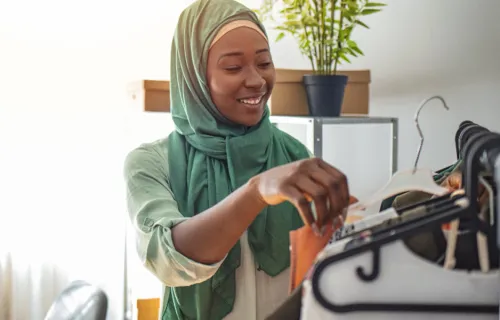As the winter approaches amidst a historical surge of energy prices, people at home and retailers alike are paying more attention than ever to their energy use. I know I am! But this also comes up in conversations [1] with Retail clients I am advising. There’s increased urgency to reduce the impact that their activities have on the planet. Whether it is driven by conscious consumers, changing regulations or intrinsic motivation, there lies an opportunity to drive action towards a sustainable retail environment.
Transitioning your business towards a regenerative model may sometimes feel like a daunting task. Much of my work focuses on thinking about ways to help companies do just that. Since starting is often the hardest part, in this blog I propose seven small steps with substantial impact to kickstart change from this coming cold season onwards.
- 1. Close the doors of physical stores
-
Closing shop doors when heating is being used reduces energy usage by up to 50% [2]. It also cuts annual emissions by up to 10 tons of CO2 [2] while enabling heating to be shut off long before the end of the day, without affecting internal temperatures. Stable store temperatures make customers feel more comfortable and are healthier for staff. Interestingly, having closed doors has also proved efficient to cut down on shoplifting [3].
Talk to your staff and neighboring stores about the benefits of closing the doors and try to come to agreements to do this together. Engage customers in your initiative and let them know what they and the environment stand to gain by supporting your business.
Are you already thinking of creative ways of letting your customers know you're open for business even if your doors aren't? When doing so remember that keeping the doors shut might be an opportunity to be more open with customers and employees in other ways!
- 2. Reduce energy consumption
-
You can start by isolating and installing LED lighting. LED lighting uses less electricity than other types of lighting and has a longer life span. Installing motion detectors will decrease energy use if your store has places that are only needed intermittently, such as stockrooms.
For energy that your business can't reduce, choose renewable sources. Look for local energy providers that offer hourly matching energy options so that you understand your hourly demand, the power sources used to cover it and their associated emissions rates. Or get inspired by this simple and visual solution CGI created with a client to keep track of exactly how much energy they’re using in real time. In this way you could rearrange some business activities to match supply from renewable sources.
- 3. Help the customer make conscious choices
-
When people decide to live life more sustainably, changing their purchasing behavior is top of their list. But who do they trust as a guide? Make customers feel empowered to make conscious choices by offering them guidance and insigths about the impact of your products on people and the environment. Doing so also communicates that your business is out to make a difference in the long term.
Employees are also a valuable source of ideas and resourceful ways to create positive impact. You can start by adopting a culture of sustainability’ ownership and engagement, training your staff on materials, care instructions and the value chain of your products.
- 4. Use durable and reusable packaging
-
From the first of January 2021 each EU member state must pay €0.80 tax per kilo of non-recycled plastic waste to Brussels [4]. In some European countries these taxes are already dripping down to companies that aren't yet cutting back on single-use plastics and non-recycled plastics.
Find ways to reduce or change packaging by asking yourself, your staff and your customers these questions:
- What parts of your packaging are strictly necessary to keep quality and brand image, and which aren't?
- Can the thickness of the packaging be reduced?
- Can the packaging materials be replaced by biodegradable options?
- Is your product suitable for reusable packaging?
- Is it logistically feasible for your company to incentivize customers to return used packaging
- What end-of-life options for your packaging are locally available for your customers?
Keep in mind that changing to sustainable packaging doesn't just lower your environmental impact. It's also a wonderful way of differentiating your brand from competitors!
- 5. Explore pre-owned, refurbished, repaired, and rental business models
-
Circular business models are no longer on the retail fringes. They are taking the central stage. Start exploring business models beyond ownership. In a circular system, a sole product can create value repeatedly. It can be not only sold, but also rented, repaired, refurbished, resold or recycled. But whether the product can stand a longer life cycle depends largely on the robustness of its design.
Up to 80% of a product’ environmental impact throughout its lifetime is determined by choices made at the design phase [5]. Things you can do are:
- Start the conversation with your stakeholders.
- Talk to your manufacturers to find opportunities to replace virgin materials with recycled or biodegradable alternatives.
- Talk to designers to reduce the number of materials used in a single product.
- Talk to customers to learn how they use your product and use this information to increase its repairability, improve operability or reduce maintenance costs.
- Rethink products and production using excess materials from other industries
- Rethink product using own material residues
- Rethink business model selling own used and refurbished products
- 6. Digitize product communication
-
Paper production, distribution, use, and disposal require a large amount of energy and raw materials. What we often don't consider are the added costs related to using paper, such storage, filing systems, printers, ink, folders and pens. Not to mention the time and energy needed by employees for handling documents.
Digitizing your inventory management is a great way of streamlining processes while reducing paperwork. Besides, customers could also find it beneficial to have digital versions of product manuals, guidelines and receipts, since these are less likely to get lost and are easy to find when needed.
- 7. Explore environmentally friendly delivery practices
-
Delivering all kinds of products to customers’ doors has become the norm. This demand for fast and prompt delivery is expected to grow by 78% by 2030, leading to 36% more delivery vehicles in large cities, increased CO2 emissions and longer passenger commuting [6].
To reduce the footprint of your deliveries, you could:
- Engage in partnerships with last-mile solutions suppliers, such as electric and zero-emissions vehicles, night delivery, or deliveries at adjacent times, which are not only more sustainable but also reduce congestion in urban settings.
- Help your customers make an informed choice by collecting and sharing data on the CO2 emissions of different delivery options available, including the environmental impact of returning products.
- Talk to your customers to learn about their willingness to wait for their items, for example by combining all their orders made over a short period of time into a single delivery.
The importance of shaping sustainable businesses grows regardless of the season we are in! This year, 68% of Retail executives interviewed as part of the CGI Voice of Our Client’ program feel strongly that environmental sustainability is core to how they will create future value for customers—well above the all-industry average of 48% [1].
Don’t know where to start? Feel free to contact me and we’ll kickstart change!
[1] CGI Voice of Our Clients – Retail, Consumer Goods & Wholesale
[2] Interim Report on the Energy Appraisal of Retail Units: Assessing the effect of open doors on energy consumption and thermal comfort; Murat Basarir, Dr. Mauro Overend; University of Cambridge
[3] Master Close the Door Campaign
[4] Long-term EU budget (2021-2027) | Plastics own resource
[5] In the Bubble: Designing in a Complex World, by John Thackara





